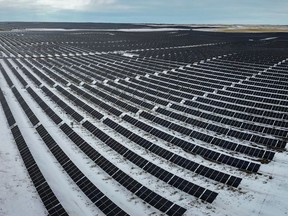The Alberta government’s pause ended March 1

Article content
Two southern Alberta solar projects have been approved since an almost seven-month moratorium on Alberta renewable project approvals was lifted last month.
The Alberta government’s pause ended March 1, with the province now adopting an “agricultural-first” approach toward new renewable projects and putting 35-kilometre buffer zones around “pristine viewscapes,” among other changes.
Advertisement 2
Article content
Article content
The Alberta Utilities Commission (AUC) approved March 19 the 230-megawatt Peace Butte Solar project, as well as a battery storage system, proposed by Aura Power Renewables Ltd. on 332 hectares of privately owned property south of Medicine Hat, in Cypress County.
In its decision, the commission said the project is a low risk to wildlife and wildlife habitat, and is situated on lower-quality agricultural land.
Two days later, the AUC approved the 450-megawatt Aira Solar Project, to be built by Aira Wind Power Inc. on about 1,800 hectares of private land roughly 35 kilometres southwest of Medicine Hat.
Concerns raised over pronghorn migration route
While concerns were raised about the proposed development’s effects on pronghorns, birds and snakes, Alberta Environment and Protected Areas provided an “overall low risk ranking to the project in relation to wildlife and wildlife habitat,” reads the commission’s report.
Professional biologist Cliff Wallis, retained by the Farmers and Ranchers Against Solar group, had argued during a hearing that wildlife researchers consider the area to be an internationally important migratory route for pronghorn, and that adding a solar project there would create an extra barrier to pronghorn movement.
Article content
Advertisement 3
Article content
“Additionally, C. Wallis noted recent research suggests that managing pronghorn migration is essential for population maintenance and that human disturbance on the landscape, such as solar projects, leads to avoidance behaviour, further reducing the pronghorn’s migratory habitat,” reads the AUC decision.
In response to the group’s concerns, Aira proposed fence adjustments that would allow pronghorn to travel east and west across the project. However, Wallis said the unfenced corridors would be insufficient to support pronghorn movement and argued against the project’s approval. At the least, he said, the approval should be deferred until an assessment examining the importance of the area for pronghorn could be completed.
“The commission accepts Aira’s proposed mitigations for impacts to pronghorn and requires a wildlife monitoring program to assess the project’s impact and the effectiveness of its proposed mitigation measures,” said the commission.
Aira’s efforts to reduce the risk to birds and snakes were sufficient, the AUC said.
Recommended from Editorial
-

Wind energy developments won’t be allowed within 35 km of Rocky Mountains: province
-

Renewables pose little threat to agriculture, environment: report
-

Alberta’s new renewable energy regulations could impact seven solar projects
-

Rural municipalities pleased with new renewables rules, but critics say fewer new projects will result
-

Alberta renewables sector fears politicization of energy as moratorium ends
Advertisement 4
Article content
The commission noted the project’s location presents an “elevated” risk that weeds could negatively affect surrounding prairie grassland, but also found Aira’s proposed weed management approach to be adequate and that negative effects can be reduced to “an acceptable degree.”
“The commission also finds the project’s other environmental impacts to be acceptable given the proposed mitigations.”
The solar project is to be built on lower-quality, private cultivated land, and the AUC expects the loss of agricultural use of the project lands to be “reversible” once the solar panels are no longer used to generate electricity.
Commission denies project
The commission also denied another project last month.
On March 22, the AUC rejected an application by Kinbrook Solar, GP Inc. and Solar Krafte Utilities Inc. to build the proposed 450-megawatt Rainier Solar farm, southwest of Brooks, on close to 1,200 hectares of private land owned by the Eastern Irrigation District.
Most of the proposed project area was native grassland, and the AUC found the solar project would have presented “high risks” to wildlife and wildlife habitat.
Advertisement 5
Article content
“The commission is not persuaded that the applicants’ proposed mitigation measures are adequate to reduce the potential environmental impacts to wildlife and wildlife habitat to an acceptable level,” the AUC said in its decision.
All three applications were paused while the Alberta government worked on new rules surrounding renewable energy projects, which were announced Feb. 28 by Premier Danielle Smith and Affordability and Utilities Minister Nathan Neudorf. The changes applied to the three southern Alberta projects, which still moved through the review process during the pause on approvals.
Article content








